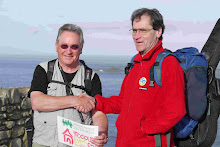


Day 11 - At 8am we were given an excellent breakfast by our host, Baron, who also said that they would be making a donation, then we set off on a cloudy day for a long walk into the Somerset Levels, and our first objective was Bridgewater. Most of the villges we have passed through have been alive, almost always with a pub, one or more shops and an active church. Nether Stowey is a large attractive village with a lot going on and a nice position just at the foot of the Quantocks. We walked out through a rather industrial 'farm' making dairy products and there certainly wasn't any of the livestock, muck or any of the usual paraphernalia of a working farm. The one person we saw en route didn't acknowledge us and we were a bit surprised to find that the footpath wasn't clearly marked and that it could easily have been blocked with a huge galvanised gate. The marking of footpaths through farms is very variable: it would seem to a farmer's advantage to have the way marked to prevent people from wandering around off the path looking for it, but all too often you have to guess. The muck on both sides of gates and styles can be very nasty and deep and I do wonder if it isn't more than just carelessness. Gates are not supposed to block paths but be capable of being opened, but this is often not the case. We have spent too much time on this walk wasting time seeking out obliterated footpaths and having to retrace our steps because of blockages or missing signs. The worst was Trevisker Fam on day 4.
We were now walking in very different countryside from previously: flat and intensively farmed with more buildings than previously. Also, we had lost the lovely wild flowers almost entirely and these were replaced by nettles, dandelions, cleavers interspersed with a few stitchworts and violets. The path went over fields to Fiddinton, with it's whitewashed tower; one of a few whitewashed buildings remain in this part of Somerset. At Cannington, we walked through a huge holiday and caravan park, exiting it along a path that looked like a stream and soon turned into one! Luckily there was a way off to the side, taking us through the agricultural college. We joined the River Parrett trail for a while which took us to the church at Wembden - an imposing red sandstone building - then entered the suburbia of Bridgewater. GPS devices are a great help when you need to get through unknown places easily, and in towns with new developments, the streets can be very confusing. Ours took us on paths through large developments to the canal basin of the Bridgewater and Taunton Canal, then into the Georgian old centre of the town the high street. Here we stopped for a coffee and did some bits of shopping which took up an hour - far longer than our normal stops!
The route out was along a main road past a huge closed down industrial site, and the rain that had threatened all morning started. On leaving the road we were soon stumbling over huge clods on an enormous ploughed field. John took a mobile phone call about accommodation as we tried to puzzle out the exit point from the field. We went past the point where it was worth turning back to look for the exit and as the field was surrounded by a deep ditch, we had no alternative to continue right around it for a very long way until we found a gate near the farm, then retrace our steps on the lane on the other side of the ditch. Not a high point! The Levels, or Sedgemoor, were once flooded and the first significant drains, or 'rheins' as they are known, were dug in the seventeenth century to enable to monks to get to their land in the middle of it. Since then, a system of drainage channels, some very large, have been dug and they, and the water levels, are now maintained by the Environment Agency. Thus there is a lot of water about and you can never assume that you can get from A to B as your way can be easily blocked by a rhein.
As we continued along byways and lanes, the weather improved with a misty sun breaking through in the late afternoon. There was not a lot of variety, so the day did begin to drag a bit as we trudged on, but one highlight was a swan sitting on its nest in the midst of one of the small rheins. We were surprised to find that accommodation was quite rare and felt lucky to be offered a room just outside the village of Mark. Our original target had been Blackford or beyond, but when we arrived at Burnt House Farm, we were very glad indeed - 22 miles was plenty!
I set off on this journey with my very excellent, but rather old Brasher Hill Masters, but these had now reached the end of their lives and each evening it took an hour or two for my feet to stop grumbling, and after all the roads today, I walked like a 70-year old into the village for supper.


No comments:
Post a Comment